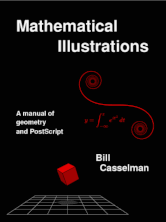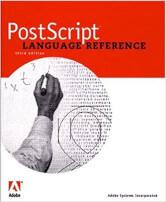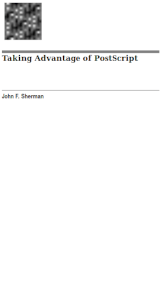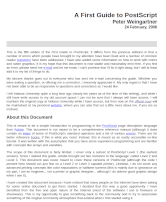Last Updated on May 22, 2022
PostScript is an interpreted, stack-based language similar to Forth but with strong dynamic typing, data structures inspired by those found in Lisp, scoped memory and, since language level 2, garbage collection.
The language syntax uses reverse Polish notation, which makes the order of operations unambiguous, but reading a program requires some practice.
PostScript is a Turing-complete programming language, belonging to the concatenative group. This means that any program you can write in any programming language, you can write in PostScript (albeit it will be slower).
PostScript files are (generally) plain text files and as such they can easily be generated by hand or as the output of user written programs. As with most programming languages, postscript files (programs) are intended to be, at least partially, human-readable.
Here’s our recommended free books to learn PostScript.
1. Mathematical Illustrations by Bill Casselman
 Mathematical Illustrations shows the reader how to use PostScript for producing mathematical graphics, at several levels of sophistication. It includes also some discussion of the mathematics involved in computer graphics as well as a few remarks about good style in mathematical illustration.
Mathematical Illustrations shows the reader how to use PostScript for producing mathematical graphics, at several levels of sophistication. It includes also some discussion of the mathematics involved in computer graphics as well as a few remarks about good style in mathematical illustration.
The early chapters (1, 3–6) offer an introduction to basic features of the language. Chapters 2 and 12 offer accounts of coordinate geometry in 2D and 3D. Chapters 7–10 explore more sophisticated features of PostScript in 2D, as well as how mathematics and graphics algorithms interact in interesting ways. The remaining chapters explore three dimensions, using a library of PostScript procedures designed for the purpose.
2. Postscript Language Reference (Third Edition) by Adobe Systems
 The PostScript Language Reference, known as the Red Book, is the complete and authoritative reference manual for the PostScript language. Prepared by Adobe Systems Incorporated, the creators and stewards of the PostScript standard, it documents the syntax and semantics of the language, the Adobe imaging model, and the effects of the graphics operators.
The PostScript Language Reference, known as the Red Book, is the complete and authoritative reference manual for the PostScript language. Prepared by Adobe Systems Incorporated, the creators and stewards of the PostScript standard, it documents the syntax and semantics of the language, the Adobe imaging model, and the effects of the graphics operators.
This Third Edition has been updated to include LanguageLevel 3 extensions, which unify a number of previous extensions and introduce many new features, such as high-fidelity color, support for masked images, and smooth shading capabilities.
3. Taking Advantage of PostScript
 Taking Advantage of PostScript is divided into four major parts.
Taking Advantage of PostScript is divided into four major parts.
Chapters 2–7 of this book introduce some basic PostScript concepts and drawing techniques. Chapter 4 shows how these simple programs can be saved as EPS files to be used within other programs. Most of the simple beginning programs are more easily drawn in a variety of graphics software programs, but they are the building blocks to the more complicated programming techniques that come in later chapters.
Chapters 8–17 cover advanced PostScript techniques that unleash the power of the PostScript Page Description Language. Much of what is covered here cannot be accomplished in available graphics software. Chapter 17 covers some advanced programming techniques and takes several designs step by step and explains how and why they were written as they are. Chapter 18 touches on some of the new features of PostScript Level 2.
Chapters 19 and 20 of this book are libraries of numerous examples of PostScript programs that can be the starting point for new designs. They generally concentrate on one visual idea or programming technique. Chapter 21 is a gallery of images.The final section of the book contains several reference appendixes.
4. A First Guide to PostScript by Peter Weingartner

A First Guide to PostScript is a simple introduction to programming in the PostScript page description language from Adobe. This document is not meant to be a comprehensive reference manual (although it does contain an index of some of PostScript’s standard operators and a list of various errors). This is meant as an easily accessible on-line tutorial. It was written with the assumption that you have some experience programming and are familiar with concepts like arrays and variables.
The new version is published under the Creative Commons Attribution-NonCommercial-ShareAlike 2.5 License.
All books in this series:
| Free Programming Books | |
|---|---|
| Ada | ALGOL-like programming language, extended from Pascal and other languages |
| Agda | Dependently typed functional language based on intuitionistic Type Theory |
| Arduino | Inexpensive, flexible, open source microcontroller platform |
| Assembly | As close to writing machine code without writing in pure hexadecimal |
| Awk | Versatile language designed for pattern scanning and processing language |
| Bash | Shell and command language; popular both as a shell and a scripting language |
| BASIC | Beginner’s All-purpose Symbolic Instruction Code |
| C | General-purpose, procedural, portable, high-level language |
| C++ | General-purpose, portable, free-form, multi-paradigm language |
| C# | Combines the power and flexibility of C++ with the simplicity of Visual Basic |
| Clojure | Dialect of the Lisp programming language |
| ClojureScript | Compiler for Clojure that targets JavaScript |
| COBOL | Common Business-Oriented Language |
| CoffeeScript | Transcompiles into JavaScript inspired by Ruby, Python and Haskell |
| Coq | Dependently typed language similar to Agda, Idris, F* and others |
| Crystal | General-purpose, concurrent, multi-paradigm, object-oriented language |
| CSS | CSS (Cascading Style Sheets) specifies a web page’s appearance |
| D | General-purpose systems programming language with a C-like syntax |
| Dart | Client-optimized language for fast apps on multiple platforms |
| Dylan | Multi-paradigm language supporting functional and object-oriented coding |
| ECMAScript | Best known as the language embedded in web browsers |
| Eiffel | Object-oriented language designed by Bertrand Meyer |
| Elixir | Relatively new functional language running on the Erlang virtual machine |
| Erlang | General-purpose, concurrent, declarative, functional language |
| F# | Uses functional, imperative, and object-oriented programming methods |
| Factor | Dynamic stack-based programming language |
| Forth | Imperative stack-based programming language |
| Fortran | The first high-level language, using the first compiler |
| Go | Compiled, statically typed programming language |
| Groovy | Powerful, optionally typed and dynamic language |
| Haskell | Standardized, general-purpose, polymorphically, statically typed language |
| HTML | HyperText Markup Language |
| Icon | Wide variety of features for processing and presenting symbolic data |
| J | Array programming language based primarily on APL |
| Java | General-purpose, concurrent, class-based, object-oriented, high-level language |
| JavaScript | Interpreted, prototype-based, scripting language |
| Julia | High-level, high-performance language for technical computing |
| Kotlin | More modern version of Java |
| LabVIEW | Designed to enable domain experts to build power systems quickly |
| LaTeX | Professional document preparation system and document markup language |
| Lisp | Unique features - excellent to study programming constructs |
| Logo | Dialect of Lisp that features interactivity, modularity, extensibility |
| Lua | Designed as an embeddable scripting language |
| Markdown | Plain text formatting syntax designed to be easy-to-read and easy-to-write |
| Objective-C | Object-oriented language that adds Smalltalk-style messaging to C |
| OCaml | The main implementation of the Caml language |
| Pascal | Imperative and procedural language designed in the late 1960s |
| Perl | High-level, general-purpose, interpreted, scripting, dynamic language |
| PHP | PHP has been at the helm of the web for many years |
| PostScript | Interpreted, stack-based and Turing complete language |
| Prolog | A general purpose, declarative, logic programming language |
| PureScript | Small strongly, statically typed language compiling to JavaScript |
| Python | General-purpose, structured, powerful language |
| QML | Hierarchical declarative language for user interface layout - JSON-like syntax |
| R | De facto standard among statisticians and data analysts |
| Racket | General-purpose, object-oriented, multi-paradigm, functional language |
| Raku | Member of the Perl family of programming languages |
| Ruby | General purpose, scripting, structured, flexible, fully object-oriented language |
| Rust | Ideal for systems, embedded, and other performance critical code |
| Scala | Modern, object-functional, multi-paradigm, Java-based language |
| Scheme | A general-purpose, functional language descended from Lisp and Algol |
| Scratch | Visual programming language designed for 8-16 year-old children |
| SQL | Access and manipulate data held in a relational database management system |
| Standard ML | General-purpose functional language characterized as "Lisp with types" |
| Swift | Powerful and intuitive general-purpose programming language |
| Tcl | Dynamic language based on concepts of Lisp, C, and Unix shells |
| TeX | Markup and programming language - create professional quality typeset text |
| TypeScript | Strict syntactical superset of JavaScript adding optional static typing |
| Vala | Object-oriented language, syntactically similar to C# |
| VHDL | Hardware description language used in electronic design automation |
| VimL | Powerful scripting language of the Vim editor |
| XML | Rules for defining semantic tags describing structure ad meaning |
